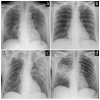Artificial Intelligence Applied to Chest X-ray for Differential Diagnosis of COVID-19 Pneumonia
- PMID: 33809625
- PMCID: PMC8000736
- DOI: 10.3390/diagnostics11030530
Artificial Intelligence Applied to Chest X-ray for Differential Diagnosis of COVID-19 Pneumonia
Abstract
We assessed the role of artificial intelligence applied to chest X-rays (CXRs) in supporting the diagnosis of COVID-19. We trained and cross-validated a model with an ensemble of 10 convolutional neural networks with CXRs of 98 COVID-19 patients, 88 community-acquired pneumonia (CAP) patients, and 98 subjects without either COVID-19 or CAP, collected in two Italian hospitals. The system was tested on two independent cohorts, namely, 148 patients (COVID-19, CAP, or negative) collected by one of the two hospitals (independent testing I) and 820 COVID-19 patients collected by a multicenter study (independent testing II). On the training and cross-validation dataset, sensitivity, specificity, and area under the curve (AUC) were 0.91, 0.87, and 0.93 for COVID-19 versus negative subjects, 0.85, 0.82, and 0.94 for COVID-19 versus CAP. On the independent testing I, sensitivity, specificity, and AUC were 0.98, 0.88, and 0.98 for COVID-19 versus negative subjects, 0.97, 0.96, and 0.98 for COVID-19 versus CAP. On the independent testing II, the system correctly diagnosed 652 COVID-19 patients versus negative subjects (0.80 sensitivity) and correctly differentiated 674 COVID-19 versus CAP patients (0.82 sensitivity). This system appears promising for the diagnosis and differential diagnosis of COVID-19, showing its potential as a second opinion tool in conditions of the variable prevalence of different types of infectious pneumonia.
Keywords: COVID-19; SARS-CoV-2; artificial intelligence; chest X-ray; community-acquired pneumonia; differential diagnosis; neural networks; sensitivity; specificity.
Conflict of interest statement
Christian Salvatore declares to be CEO of DeepTrace Technologies SRL, a spin-off of Scuola Universitaria Superiore IUSS, Pavia, Italy. Matteo Interlenghi, Annalisa Polidori, and Isabella Castiglioni declare to own DeepTrace Technologies S.R.L shares. Simone Schiaffino declares to have received travel support from Bracco Imaging and to be a member of the speakers’ bureau for General Electric Healthcare. Marco Alì declares to be a scientific advisor for Bracco Imaging. Francesco Sardanelli declares to have received grants from, or to be a member of, the speakers’ bureau/advisory board for Bayer Healthcare, the Bracco Group, and General Electric Healthcare. All other authors have nothing to disclose.
Figures


Similar articles
-
Machine learning applied on chest x-ray can aid in the diagnosis of COVID-19: a first experience from Lombardy, Italy.Eur Radiol Exp. 2021 Feb 2;5(1):7. doi: 10.1186/s41747-020-00203-z. Eur Radiol Exp. 2021. PMID: 33527198 Free PMC article.
-
Using Artificial Intelligence to Detect COVID-19 and Community-acquired Pneumonia Based on Pulmonary CT: Evaluation of the Diagnostic Accuracy.Radiology. 2020 Aug;296(2):E65-E71. doi: 10.1148/radiol.2020200905. Epub 2020 Mar 19. Radiology. 2020. PMID: 32191588 Free PMC article.
-
An original deep learning model using limited data for COVID-19 discrimination: A multicenter study.Med Phys. 2022 Jun;49(6):3874-3885. doi: 10.1002/mp.15549. Epub 2022 Apr 18. Med Phys. 2022. PMID: 35305027 Free PMC article.
-
Thoracic imaging tests for the diagnosis of COVID-19.Cochrane Database Syst Rev. 2020 Sep 30;9:CD013639. doi: 10.1002/14651858.CD013639.pub2. Cochrane Database Syst Rev. 2020. Update in: Cochrane Database Syst Rev. 2020 Nov 26;11:CD013639. doi: 10.1002/14651858.CD013639.pub3. PMID: 32997361 Updated.
-
Artificial Intelligence-Assisted Chest X-ray for the Diagnosis of COVID-19: A Systematic Review and Meta-Analysis.Diagnostics (Basel). 2023 Feb 5;13(4):584. doi: 10.3390/diagnostics13040584. Diagnostics (Basel). 2023. PMID: 36832072 Free PMC article. Review.
Cited by
-
Inter- and Intra-Observer Agreement When Using a Diagnostic Labeling Scheme for Annotating Findings on Chest X-rays-An Early Step in the Development of a Deep Learning-Based Decision Support System.Diagnostics (Basel). 2022 Dec 9;12(12):3112. doi: 10.3390/diagnostics12123112. Diagnostics (Basel). 2022. PMID: 36553118 Free PMC article.
-
The role of artificial intelligence in plain chest radiographs interpretation during the Covid-19 pandemic.BJR Open. 2022 May 26;4(1):20210075. doi: 10.1259/bjro.20210075. eCollection 2022. BJR Open. 2022. PMID: 36105414 Free PMC article. Review.
-
A new classification method for diagnosing COVID-19 pneumonia based on joint CNN features of chest X-ray images and parallel pyramid MLP-mixer module.Neural Comput Appl. 2023 Apr 28:1-13. doi: 10.1007/s00521-023-08604-y. Online ahead of print. Neural Comput Appl. 2023. PMID: 37362575 Free PMC article.
-
Application of Table Tennis Ball Trajectory and Rotation-Oriented Prediction Algorithm Using Artificial Intelligence.Front Neurorobot. 2022 May 11;16:820028. doi: 10.3389/fnbot.2022.820028. eCollection 2022. Front Neurorobot. 2022. PMID: 35645761 Free PMC article.
-
Low-cost thermal imaging with machine learning for non-invasive diagnosis and therapeutic monitoring of pneumonia.Infrared Phys Technol. 2022 Jun;123:104201. doi: 10.1016/j.infrared.2022.104201. Epub 2022 May 14. Infrared Phys Technol. 2022. PMID: 35599723 Free PMC article.
References
-
- Bordi L., Nicastri E., Scorzolini L., Di Caro A., Capobianchi M.R., Castilletti C., Lalle E. Differential diagnosis of illness in patients under investigation for the novel coronavirus (SARS-CoV-2), Italy, February 2020. Eurosurveillance. 2020;25:2000170. doi: 10.2807/1560-7917.ES.2020.25.8.2000170. - DOI - PMC - PubMed
-
- Wynants L., van Calster B., Collins G.S., Riley R.D., Heinze G., Schuit E., Bonten M.M.J., Dahly D.L., Damen J.A., Debray T.P.A., et al. Prediction models for diagnosis and prognosis of COVID-19: Systematic review and critical appraisal. BMJ. 2020;369:m1328. doi: 10.1136/bmj.m1328. - DOI - PMC - PubMed
LinkOut - more resources
Full Text Sources
Other Literature Sources
Miscellaneous

